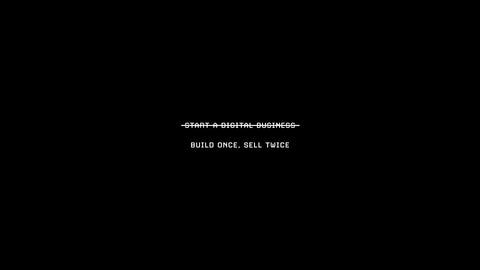What it means:
Growth looks like gaining things, but it's actually about losing things. You get better by removing, not by adding.
Why it's true:
In skill:
- Beginner writer: uses too many words
- Expert writer: removes everything unnecessary
- "I didn't have time to write a short letter, so I wrote a long one instead"
- Getting better = cutting more
- Mastery is elimination, not accumulation
In business:
- Startup: tries to do everything for everyone
- Successful company: says no to almost everything, does one thing perfectly
- Apple killed most product lines to focus on iPhone
- Growth came from subtraction, not addition
- Strategy is deciding what NOT to do
In fitness:
- Beginner: adds exercises, supplements, programs
- Advanced: removes junk food, alcohol, late nights, stress
- The gains come from what you stop doing
- Six-pack is revealed by removing fat, not adding muscle
- Performance improves by removing what slows you down
In relationships:
- Young: tries to please everyone, be everything to everyone
- Mature: removes toxic people, bad dynamics, people-pleasing
- Better relationships come from fewer, deeper connections
- Growth = cutting out what doesn't serve you
- Quality over quantity is subtraction
In possessions:
- Accumulation phase: buy everything
- Maturity phase: get rid of most of it
- The less you own, the more freedom you have
- Minimalism is growth through subtraction
- Every object you remove creates space for living
In decisions:
- Inexperienced: wants all options open
- Experienced: closes most options deliberately
- Growth = narrowing focus
- Saying yes to everything = saying no to excellence
- Depth requires abandoning breadth
The mechanism:
Addition (what it looks like):
- Gaining skills
- More knowledge
- Better habits
- Increased capacity
- Higher performance
- Greater clarity
Subtraction (what's actually happening):
- Removing bad technique
- Eliminating false beliefs
- Cutting toxic habits
- Dropping what doesn't work
- Stripping away inefficiencies
- Clearing mental clutter
The illusion:
Growth FEELS like addition because you're:
- Learning new things (actually: unlearning wrong things)
- Building strength (actually: removing weakness)
- Gaining confidence (actually: losing fear)
- Increasing knowledge (actually: removing ignorance)
- Getting better (actually: eliminating what made you worse)
Examples where subtraction = growth:
Michelangelo:
- "The sculpture is already in the marble. I just remove what doesn't belong."
- Creation through subtraction
- Art revealed by removing excess
- Growth = revealing what was always there
Writing:
- First draft: 5,000 words
- Final draft: 1,000 words
- Better = shorter
- Every cut improves it
- The best sentences are what's left after removing everything else
Code:
- Junior developer: adds features, more lines of code
- Senior developer: removes features, deletes code
- "The best code is no code"
- Performance improves with less code
- Simplicity through subtraction
Companies:
- Facebook started as social network for colleges only (subtraction of audience)
- Google started as search only (subtraction of features)
- iPhone removed keyboard (subtraction of components)
- Success came from doing less, better
Diets:
- Don't add superfoods
- Remove processed food, sugar, alcohol
- Health improves by subtraction
- "Eat food, not too much, mostly plants" = subtraction
- The best diet removes, not adds
The formula:
Beginner strategy: Add more (effort, hours, features, complexity) Expert strategy: Remove more (waste, inefficiency, distraction, unnecessary)
Beginner: More = better Expert: Less = better
Why people don't see it:
Addition is visible:
- You can see what you added
- Feels like progress
- Easy to measure (I learned X, I built Y)
- Socially legible (others see what you gained)
- Feels productive
Subtraction is invisible:
- You can't see what's not there
- Feels like loss initially
- Hard to measure (how do you measure what's gone?)
- Not socially legible (others don't see what you removed)
- Feels like sacrifice
The trap:
Most people keep adding:
- More courses
- More books
- More tools
- More commitments
- More possessions
- More complexity
They think: "If I just add more, I'll get there"
Reality: You're drowning in excess. Remove to grow.
The growth pattern:
Phase 1: Addition (necessary)
- Explore everything
- Try many things
- Collect experiences
- Build base knowledge
- Wide and shallow
- Accumulation mode
Phase 2: Subtraction (where growth happens)
- Cut what doesn't work
- Focus on what matters
- Remove distractions
- Eliminate waste
- Narrow and deep
- Refinement mode
Phase 3: Mastery (pure subtraction)
- Only essentials remain
- Every move is necessary
- Nothing wasted
- Maximum efficiency
- Pure signal, zero noise
- Simplicity
Most people stay in Phase 1 forever. Growth happens in Phase 2. Mastery is Phase 3.
Applications:
In productivity:
- Don't add more tasks
- Remove tasks that don't matter
- Most to-do items can be deleted
- Growth = doing fewer things better
- The productive remove; the busy add
In learning:
- Don't add more information
- Remove misconceptions
- Unlearn bad mental models
- Clear mental clutter
- Understanding is removal of confusion
In business:
- Don't add more features
- Remove complexity
- Cut products that don't work
- Focus on core offering
- Growth = simplification
In life:
- Don't add more commitments
- Remove obligations that don't serve you
- Cut toxic relationships
- Eliminate time-wasters
- Quality of life improves by subtraction
In art:
- Don't add more elements
- Remove everything unnecessary
- "Perfection is achieved not when there is nothing more to add, but when there is nothing left to take away"
- Every great work is subtraction
The counterintuitive truth:
To grow:
- Remove more than you add
- Cut more than you build
- Eliminate more than you accumulate
- Simplify more than you complicate
- Focus more than you expand
The ratio:
For every 1 thing you add, remove 10 things.
Why subtraction is hard:
Loss aversion:
- Losing something feels worse than gaining something feels good
- Subtraction feels like loss
- Addition feels like gain
- Psychology works against subtraction
Sunk cost:
- "I already invested in this"
- "I paid for this course/tool/thing"
- "I spent time learning this"
- Hard to remove what you invested in
Identity:
- We are what we accumulate
- Removing things feels like losing self
- "I'm a person who reads 100 books/year" (quantity identity)
- Subtraction threatens identity
Social pressure:
- "More is better" is the message
- Success looks like accumulation
- Hard to explain "I removed X" as growth
- Addition is celebrated; subtraction is questioned
The practice:
Daily subtraction:
- What can I stop doing?
- What can I eliminate?
- What can I simplify?
- What can I remove?
- What's taking space but not giving value?
Weekly review:
- What did I do that didn't matter?
- What can I cut from next week?
- What commitments can I exit?
- What possessions can I remove?
Monthly audit:
- What projects should I kill?
- What relationships should I end?
- What subscriptions should I cancel?
- What beliefs should I abandon?
The ultimate truth:
You're not growing by adding more. You're growing by revealing what was always there.
The real you is under all the excess. The best work is under all the unnecessary. The good life is under all the clutter.
Growth is subtraction disguised as addition.
Remove to reveal. Cut to create. Eliminate to elevate. Subtract to grow.








